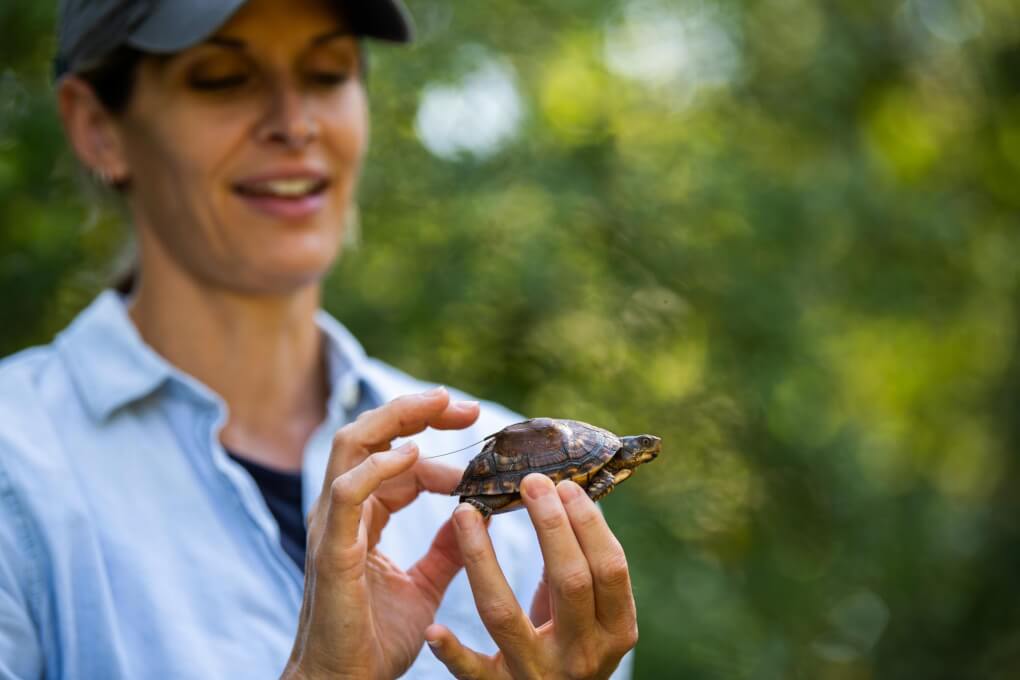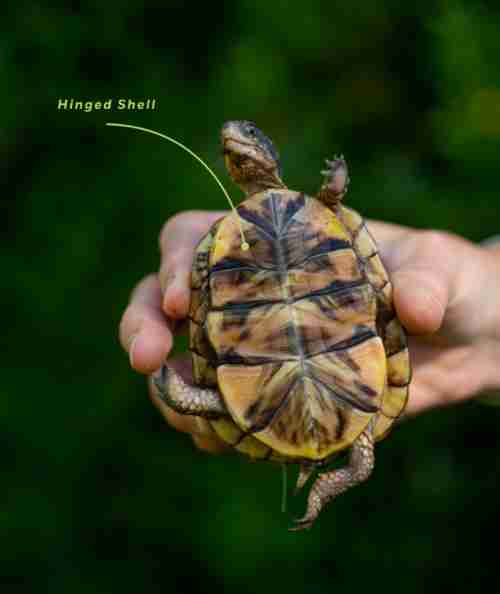
This Eastern box turtle has developed the hinge on its shell that
allows the species to form a protective box when threatened.
Jennifer Moore, associate professor of wildlife biology and natural
resources management, joined Kuzma in sifting through the vegetation,
and the pair eventually found the hatchling, outfitted with a tiny
transmitter. Small and vulnerable, the turtle had continued to evade
the predation that is a disproportionate threat to these animals,
particularly from raccoons.
Next, Moore and Kuzma walked along the trail to a different point in
the Pierce Cedar Creek Institute, where they expected to find an
Eastern box turtle released in May after spending about nine months at
John Ball Zoo in what is called a headstarting program, helping them
grow faster than they would when born in the wild.
This turtle, while only a year older than the first hatchling, was
substantially larger and, crucially, had developed the hinge on its
shell that allows the species to form a protective box for other body
parts when threatened by a predator. Once they can do that, Moore
said, the turtles are nearly impenetrable “tanks.”
That’s why the boost this and other turtles have received as
hatchlings could hold the key to helping restore a small, aging
Eastern box turtle population at Pierce Cedar Creek Institute.
Moore and Bill Flanagan, conservation manager at John Ball Zoo, have
for several years led efforts on a collaboration at the nature center
to carry out this conservation technique, one that Moore says is
demonstrably working.
“So far they are having such great survival,” Moore said. “Adult
turtles are facing all sorts of mortality that they wouldn’t have in
the past, so our hope is that we can boost the survival of these
younger age classes to compensate for some of that adult mortality
that we can’t really control.”
Growth, not dormancy
The accelerated growth of the hatchlings during the headstarting
process is achieved by keeping them fed in the months after their
birth. In the wild, hatchlings go to sleep and into dormancy soon
after they are born, Moore said.
Feeding the babies right after birth allows them to achieve three to
four years of growth in less than a year. Importantly, that sped-up
maturation process allows them to develop the hinge on their shell to
enclose themselves and diminish their susceptibility to predators,
Moore said.
Headstarting starts with gathering eggs from nests, typically in
August. Kuzma tracked mothers, sometimes late at night, to see when
they might be laying eggs. Mother Eastern box turtles can be picky
about their nesting areas, often checking out several spots before
settling on a location for the typical clutch of three to 12 eggs,
Moore said.
The eggs are then brought to the zoo, where they are incubated until
hatching. After hatching, some of babies are placed in plastic tubs on
shelves in a special room in the zoo’s quarantine area at the
veterinary hospital. Color codes connect them to their mothers, who
are given names of fruit to distinguish them. These babies are part of
the headstarting.

Bill Flanagan, conservation manager at John Ball Zoo, and Kaylee
DeBoef, veterinary technician, have collaborated on the headstarting program.
Some hatchlings are returned to the nature preserve’s grounds and
outfitted with transmitters to monitor their survival without the
advantages of headstarting. The tiny hatchling that Kuzma and Moore
dug out of the vegetation was part of a clutch from “Pear,” who
unfortunately was found deceased later, after her eggs were laid.
A few of Pear’s babies were also part of the headstarting group.
Those hatchlings, along with those from other mothers, are given a
living environment that mimics the wild while also providing some enhancements.
The tubs each contain sphagnum moss, allowing the hatchling to engage
in their natural behavior of burrowing, Flanagan said. One set of
lights encourages basking behavior, while another set provides the
necessary UVB rays to promote bone growth.
They receive a specialized diet of pellets and worms. And they also
have regular “salad days,” when turtle salads, including ingredients
like greens, carrots, and radishes, appear in their tubs.
The special salads are also specially sized, meaning the zoo team is
also peeling and cutting the vegetables and fruits in the salad to
make the ingredients an edible size for the turtle hatchlings, said
Kaylee DeBoef, veterinary technician.
Beyond the conservation aspect of this effort, the information
gathered is also providing a deeper understanding of these turtles
with a geographic range from northern Michigan to Florida to the East
Coast. The information on babies and younger turtles is particularly
limited, the researchers said.
At its core, though, headstarting is a vital conservation technique,
Flanagan said, adding that a signature focus of the zoo’s conservation
program is Michigan’s rare turtles.
“You definitely want the natural systems to run on their own as much
as possible,” Flanagan said. “But these animals and these habitats are
in the situation they’re in because of anthropogenic impact and to
think they’re just going to fix themselves with us not touching it is
not viable.”
Student researcher, key role
For four years now, first as an undergraduate and now as a graduate,
Kuzma has done the intensive fieldwork necessary to track these
turtles. Flanagan said Kuzma is tracking more than two dozen turtles,
which he described as an enormous undertaking.
Added Moore: “Faith is really driving the project. None of this would
happen without Faith.”
Kuzma, who was living in housing provided by Pierce Cedar Creek
Institute, has a deep familiarity with the grounds and the way the
turtles inhabit the area.
“I feel like this has been a really good lesson in the power of
collaboration. We have the Institute, and John Ball Zoo and Grand
Valley and without any one of those pieces this project wouldn’t be
possible,” Kuzma said.
Kuzma, who hopes to continue research work with turtles after
graduation, said the opportunity to take a lead role in this project
provided valuable experience.
“I’ve learned a lot about how to do science and how to plan out a
field season and what goes into seeking grants,” Kuzma said.
The research team is evaluating how long to continue with the
headstarting program or to possibly develop other conservation
techniques. The researchers say they have been encouraged by the
survivability of the turtles and their behavior when reintroduced to
the wild.
“This is one of the coolest, most hands-on, boots-on-the-ground
projects,” Moore said. “We’re having this direct impact on these
animals, and it’s very obvious and measurable.”















